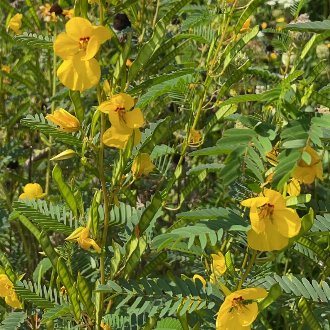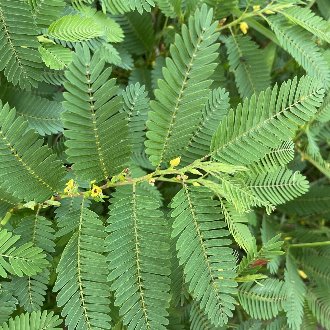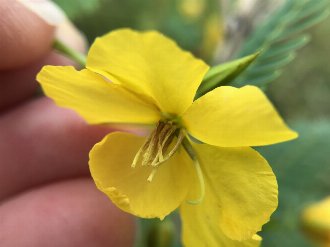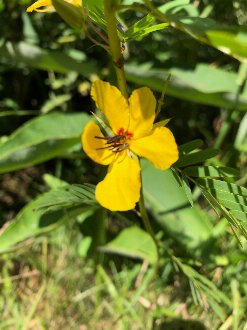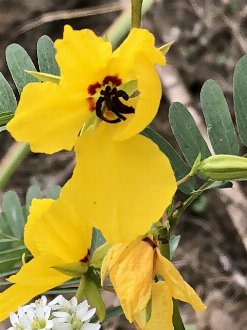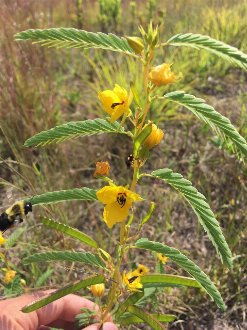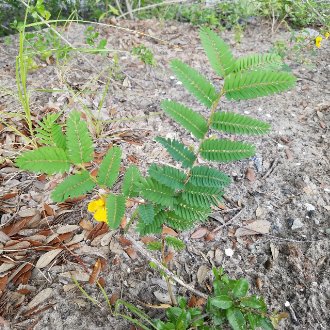Partridge Pea (Chamaecrista fasciculata (Michx.) Greene)
↑Summary
A showy, nitrogen-fixing annual of sunny, average to dry habitats, native to central to eastern North America.
↑Description & Identification
An annual plant growing to about 2 feet (5 dm) in height, occasionally branching near the base. Smaller plants are upright, but taller plants often sprawl or lean on support. Stems vary from hairless to pubescent, and are initially green but often become dark reddish brown with age. Leaves are alternately arranged on the stem, and divided into about 20 pairs of opposite leaflets, pinnately arranged. There is a small nectar-producing gland on the petiole of each leaf. Leaves may fold when touched, and also fold at night.
Flowers are slightly asymmetrical, with five yellow petals, 10 stamens. Fruits are a long pod, initially green, turning dark brown and coiling to pop open when ripe. Seeds are flat, squarish, off-white to greenish when unripe, ripening to near-black, and often pitted when fully dry. Plants in fall often have flowers, unripe, ripe but unopened, and opened pods all at the same time.
This species can be tricky to tell apart from other species of its genus until it blooms, but in most areas there is only one other species to need to distinguish it from.
↑Similar Plants
↑Habitat
Found in a variety of sunny to mostly-sunny, dry, nitrogen-poor habitats, including prairies, limestone barrens, and many anthropogenic habitats including abandoned fields, roadsides, and areas along railroads. Favors areas that have been recently disturbed, including by fire, removal or disturbance of soil, logging, and mowing or application of herbicide.
Most common on sandy soils to sandy loams, but also tolerates clay and gravel soils. Intolerant of acidic soil, usually only found on soils with pH >= 5.0.
Populations usually peak in the first few years following disturbance, and then decline.
Found in small numbers in late successional stages of grasslands and open forests, where it is usually restricted to local sites where drier or more nutrient-poor conditions allow more sunlight to reach the ground. In meadow plantings that are mowed once a season but not otherwise disturbed, this species is usually mostly eliminated over time, except along paths and edges where it persists in large numbers due to high-light conditions in more frequently-mowed grass.
↑Life Cycle
Partridge pea is a summer annual, with seeds germinating in late spring. Germination is variable, irregular, and dependent on conditions. It is usually triggered by heat following a period of cold dormancy, and is aided by mechanical damage to the hard seed coat.
Seedlings are not frost-tolerant and can be killed by frost if they germinate too early, which can happen after fires that occur during winter. On ideal sites, seedling development keeps pace with competing vegetation. If soil conditions are too moist or nutrient-rich, however, plants may get out-competed later in the growing season.
Seedlings quickly establish a taproot, followed by a secondary fibrous root system. Vegetative growth is usually upright when plants are surrounded by competing vegetation, but in the absence of support, stems sprawl horizontally, which can enable them to cover exposed, barren areas such as rocks, where there is little or no competing vegetation. Plants branch occasionally, near the base of the plant, especially if able to expand to capture more light.
Plants can resprout to some degree if top-killed early in the season, but this species is not well-adapted to repeated mowing during the growing season due to its upright growth habit.
Flowering typically begins in June and continues through October. Flowers do not provide nectar, but glands on the petioles of each leaf, near each flower, supply nectar, and the anthers of the flowers also attract pollinators by supplying food pollen on the conspicuous purple anthers, which are separate from the yellow anthers that produce reproductive pollen. Although flowers are usually cross-pollinated, they can be self-fertile in the absence of pollination. Seeds from older flowers begin maturing and may mature fully, even having their pods open, while the plant is still flowering. Seed production continues until the plant is killed by frost. Plants usually survive periods of drought, but drought can temporarily stop flowering.
This species is capable of rapid plant movement, and can also close their leaves in response to touch, which can protect them from herbivory, but this species is not always as touch-responsive as other Chamaecrista species. Usually the leaves close at night and open during the day. Drought-stressed plants will keep their leaves folded.
We found conflicting information on seed banking, with some sources claiming this species forms a long-term seed bank, but others saying that such seed banking had not been documented or established. Many legumes form a long-term seed bank, and the hard seed coat of this species, and seeds that do not often germinate unless scarified and/or exposed to heat, makes it likely that it could form a long-term seed bank.
Fire usually kills plants, but often creates conditions for the plant to thrive in subsequent years, particularly by releasing bioavailable forms of nitrogen back into the atmosphere. Dormant seeds can survive all but the most severe fires.
↑Faunal Associations
The large, nutritious seeds of this species are a key food for the northern bobwhite (Colinus virginianus) quail, and the greater prairie chicken (Tympanuchus cupido), and are also eaten by other larger birds, as well as rats and mice.
The leaves are nutritious but contain a cathartic substance which can harm mammals eating this plant in large quantities; for this reason most mammals usually avoid browsing this plant, but livestock can sometimes consume it and become sick. White-tailed deer browse this plant in small quantities. The foliage and structure of the plant also provides important cover for birds and small mammals, especially in more open habitats where it can be one of the denser-growing plants.
The flowers are primarily pollinated by long-tongued bees, including honeybees, bumblebees, long-horned bees (Melissodes sp.), and leaf-cutting bees (Megachile sp.) Two bee species, Walsh's anthophora Anthophora walshii and Svastra atripes, specialize on this and closely-related plants. These pollinators are attracted by the food pollen. The petiolar glands attract a different set of pollinators, including Halictid bees, flies, ants, and wasps, less commonly including velvet ants (Mutillidae)
In addition to pollinators, this species supports a large number of other insects. The foliage is eaten by the larvae of the little yellow (Eurema lisa), sleepy orange (Eurema nicippe), and cloudless sulfur (Phoebis sennae), and ceraunus blue (Hemiargus ceraunus) butterflies, as well as numerous moths, including Adelphia petrella, io moth (Automeris io), and Caristanius decoloralis, Caribbean pod borer (Fundella pellucens), common tan wave moth (Pleuroprucha insulsaria), polyhymno moth (Polyhymno luteostrigella), and the red-necked peanutworm moth (Stegasta bosqueella). The foliage is also eaten by the bean leaf beetle (Cerotoma trifurcata), and the seeds by the partridge pea seed beetle (Sennius cruentatus).
↑Control
In its native range, this plant is usually seen as desireable and rarely removed.
However, outside its native range it has the potential to become invasive and may be difficult to remove. It has been introduced and established a sustaining population in Bolivia. It is best to avoid planting this species outside its native range.
↑Uses
This species is frequently used in native plant gardens, where it is valued for its showy flowers, ease of growing, and high value to wildlife.
In its range, it is also considered one of the best species to plant to stabilize soil and control erosion, and restore soil fertility. It has a high nitrogen-fixing capacity even compared to other legumes. It greatly aids in the establishment of perennials in the 3-4 years following its establishment.
It is also used in roadside mixes where it hinders the growth of invasive plants that favor disturbed conditions.
In Georgia and Florida, it is considered an important honey plant, particularly in regions where other honey sources are scarce.
↑Related Plants
Numerous other Chamaecrista species, mostly native, but a few introduced, are found in North America. Most of these have limited areas of distribution along the southernmost parts of the U.S. and into Mexico; the only that overlaps widely with this species in range is sensitive partridge pea (Chamaecrista nictitans).
After these plants, the next-most-closely-related plants are of the Cassia and Senna genera. Cassia are only found in far southern Florida, including one native and three introduced species, but there are numerous Senna species, both native and introduced, in various parts of North America.
↑Links & External Resources
• Partridge Pea | Fire Effects Information System (FEIS) (About This Site)
• Chamaecrista fasciculata (Partridge Pea) | Illinois Wildflowers (About This Site)
• Chamaecrista fasciculata (partridge pea) | USDA PLANTS Database (About This Site)
• Chamaecrista fasciculata | Go Botany (About This Site)
• Partridge Pea | iNaturalist (About This Site)
• Chamaecrista fasciculata (Partridge Pea) | Missouri Botanical Garden Plant Finder (About This Site)
• Chamaecrista fasciculata | Biota of North America Project (BONAP) (About This Site)
• Chamaecrista fasciculata | NatureServe Explorer (About This Site)
• Chamaecrista fasciculata | Missouri Plants (About This Site)
• Partridge Pea | Maryland Biodiversity Project (About This Site)
• Chamaecrista fasciculata (Partridge Pea) | Minnesota Wildflowers (About This Site)
• Chamaecrista fasciculata (Michx.) Greene var. macrosperma (Fernald) C. F. Reed (Marsh Patridge-pea, Marsh Senna) | Digital Atlas of the Virginia Flora (About This Site)
• Chamaecrista fasciculata (Michx.) Greene var. fasciculata (Common Partridge-pea) | Digital Atlas of the Virginia Flora (About This Site)



